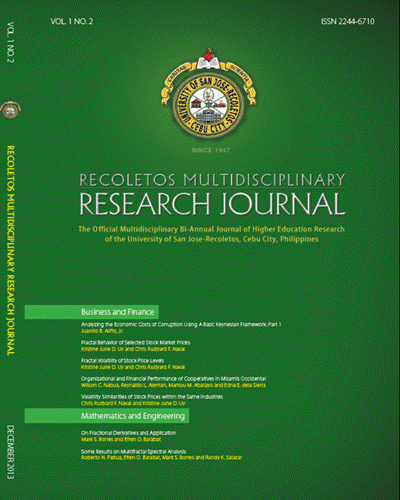Interpretation of Fractal Dimensions in Poverty Estimation
DOI:
https://doi.org/10.32871/rmrj1301.02.10Keywords:
poverty incidence, income-based poverty measure, fractal statisticsAbstract
The paper analyzed the poverty incidence data among families in the Philippines
across the different provinces for three periods: 2006, 2009, and 2012, using a surrogate measure of data roughness through fractal dimensions. Fractal dimensions as statistical quantities are robust measures which are not easily influenced by extreme observations unlike other variance-based poverty measures. Results showed that poverty incidence is most pronounced and severe in 2009 and significantly least severe in 2012. This did not coincide with the classical analysis of the National Statistical Coordination Board which averred no significant improvement in the poverty situation in the Philippines using the
same data report. Moreover, multifractal spectrum analysis revealed that some provinces which used to be members of the 20 poorest provinces were delisted in 2012. The attribution of the improvement in the poverty situation are discussed in the paper considering some of the poverty alleviation projects in the Arroyo administration and the current Aquino administration’s poverty alleviation thrusts.
References
Albert, Jose Ramon and Andre Philippe Ramos (2010). “Trends in Household Vulnerability,â€Philippine Institute for Development Studies, Discussion Paper Series No. 2010- 01.
Asian Development Bank (2006). Poverty in the Philippines: Incomes, Assets and Access. Manila:Asian Development Bank
Asian Development Bank (2009). Poverty in the Philippines: Causes, Constraints, Opportunities. Mandaluyong City: Asian Development Bank
Asian Development Bank (2010). Poverty in the Philippines: Causes, Constraints and Opportunities. Manila: Asian Development Bank
Balisacan, Arsenio (2007). “Why Does Poverty Persist in the Philippines? Facts, Fancies andPolicies,†Agricultural and Development Discussion Paper Series 2007-1, Southeast Asian Regional Center for Graduate Study and Research in Agriculture.
Balisacan, Arsenio, Rosemarie Edillion, Alex Brilliantes and Dante Canlas (2002). Approaches to Targeting the Poor. Makati: National Economic and Development Authority and the United Nations Development Program.
Balisacan, Arsenio and Nobuhiku Fuwa (2004). “Going Beyond Cross Country Averages: Growth, Inequality and Poverty Reduction in the Philippines,†World Development 32 (11), pp. 1891- 1907.
Balisacan, Arsenio, Sharon Faye Piza, Dennis Mapa, Carlos Abad Santos and Donna Mae Odra(2010). “Tackling Poverty and Social Impacts: Philippine Response of the Crisis to the Global Economic Crisis,†Report to the United Nations Development Program, Manila.
Buendia, Emmanuel (2005). Democratizing Governance in the Philippines: Redefining and Measuring the State of People’s Participation in Governance. Quezon City: University of the Philippines.
Canlas, Dante, Fernando Aldaba and Emmanuel Esguerra (2006). “Growth, Employment Creation and Poverty Reduction,†Paper prepared for the National Employment Summit.
Castro, Lina (2008). “2006 Poverty Statistics for the Basic Sectors,†Presentation to the Users’Forum on the 2006 Poverty Statistics for the Basic Sectors and 2006 Child Development Index,†Makati, Philippines.
De Dios, Emmanuel (1993). Poverty, Growth and the Fiscal Crisis. Makati: Philippine Institute for Development Studies
Di Gropello, Emanuela with Hong Tan and Prateek. Tandon (2010). Skills for the Labor Market inthe Philippines. Washington, D.C.: World Bank.
Dy, Rolando (2011). “Philippine Agriculture and Fishery: Challenges, Opportunities and Global Competitiveness,†Presentation to the Department of Agriculture.
Padua, Roberto, N. with Palompon, Daisy, R. and Ontoy, Dexter S. (2012) “Data Roughness and Fractal Statistics†(CNU Journal of Higher Education, Vol. 6, No.1, CHED-JAS Category A, pp. 87-101)
Padua, Roberto with Barabat, Efren (2013) “ On the Properties of Multifractal Spectrum†(The Recoletos Journal of Higher Education, Vol. 1, No.1, Research Journal of the University of San Jose Recoletos,
CHED-JAS Category B, pp. 78-89)
Downloads
Published
How to Cite
Issue
Section
License
Copyright of the Journal belongs to the University of San Jose-Recoletos


